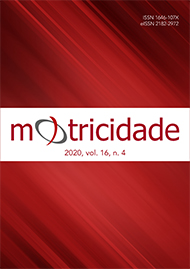Comparison of anthropometric indicators in rhythmic gymnastics athletes satisfied and dissatisfied with body image
DOI:
https://doi.org/10.6063/motricidade.19232Abstract
This study aimed to compare body mass index [BMI], triceps skinfold (DCTR), subscapular skinfold (DCSE) and body fat (%BF) in rhythmic gymnastics (GR) athletes, satisfied and dissatisfied with body image (CI). Through a cross-sectional study with 38 athletes practicing GR from Oeste Paranaense. The CI was assessed with the Body Shape Questionnaire, body mass and height were measured, and the BMI was calculated. The DCTR and DCSE were used to calculate the %GC (Slaughter equation). The economic level was verified with the Brazil Economic Classification Criterion, and sexual maturation was self-reported with Tanner boards. Independent T-test and Chi-square and covariance analysis (ANCOVA) were employed to control the interference of economic level and maturational stage, with p <0.05. Gymnasts dissatisfied with HF presented higher BMI values (mean: 19.01 Kg/m²; standard deviation [SD]: 0.65 Kg/m²), DCTR (mean: 9.26 mm; SD: 0, 65 mm), DCSE (mean: 7.33 mm; SD: 0.55 mm) and %BF (average: 20.75; SD: 0.96) when compared to gymnasts satisfied with HF, even after control economic level and maturational stage. GR athletes dissatisfied with HF presented higher values for anthropometric indicators.
Downloads
Published
Issue
Section
License
The authors of submitted manuscripts must transfer the full copyright to Journal Motricidade / Sílabas Didáticas Editions. Granting copyright permission allows the publication and dissemination of the article in printed or electronic formats, and copyrights start at the moment the manuscript is accepted for publication. It also allows Journal Motricidade to use and commercialise the article in terms of licensing, lending or selling its content to indexation/abstracts databases and other entities.
According to the terms of the Creative Commons licence, authors may reproduce a reasonable number of copies for personal or professional purposes, but without any economic gain. SHERPA/RoMEO allows authors to post a final digital copy (post-printing version) of the article on their websites or on their institutions' scientific repository.


